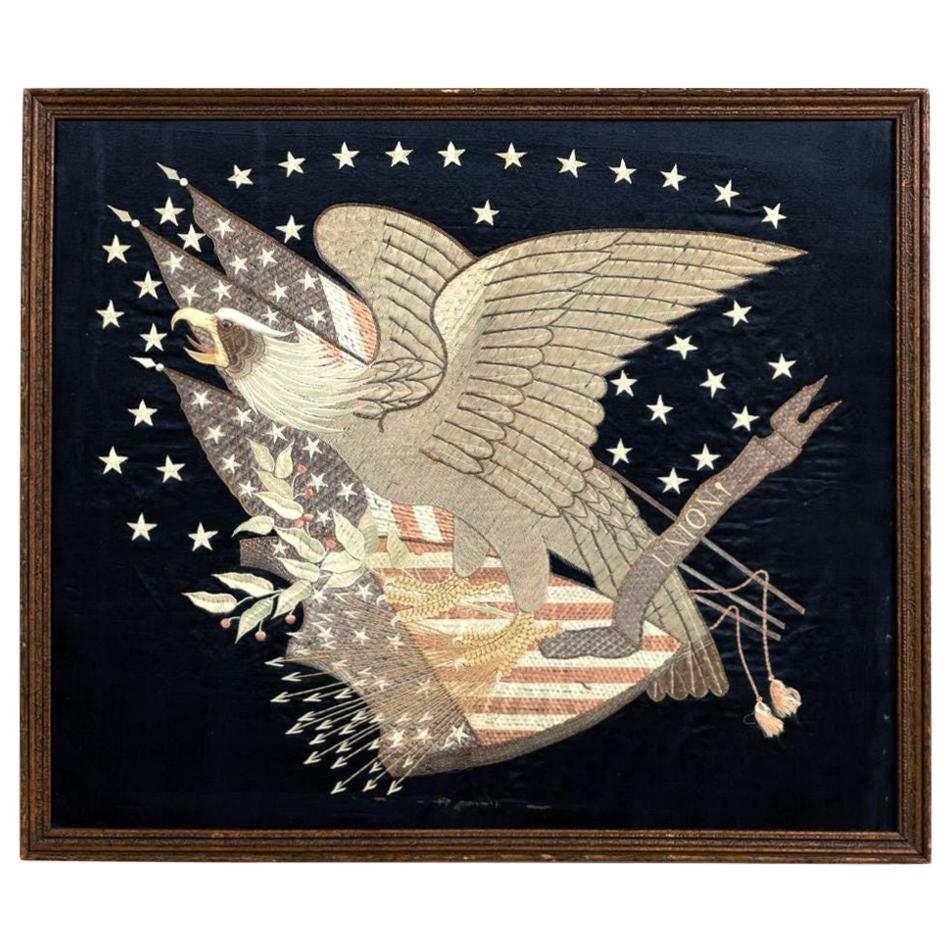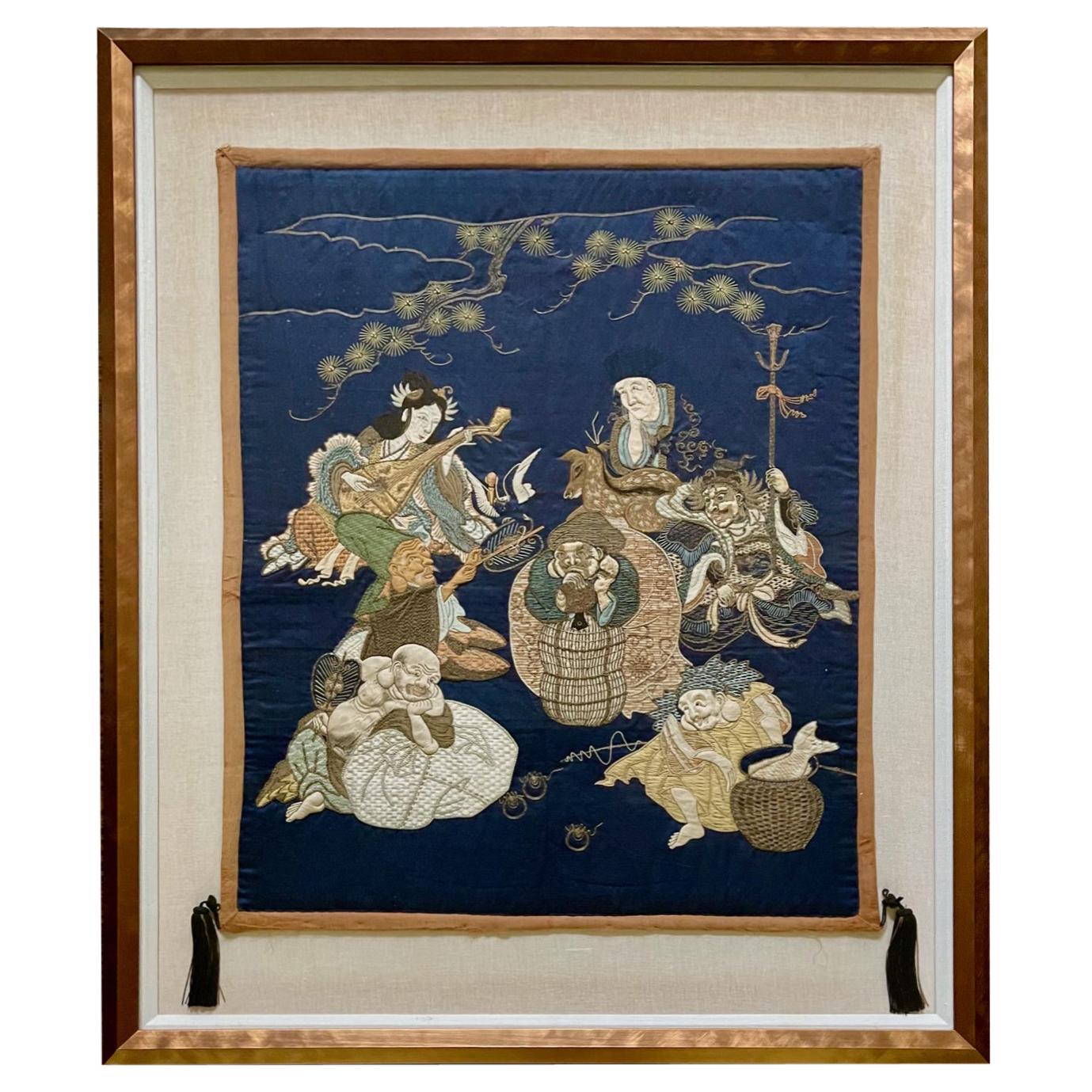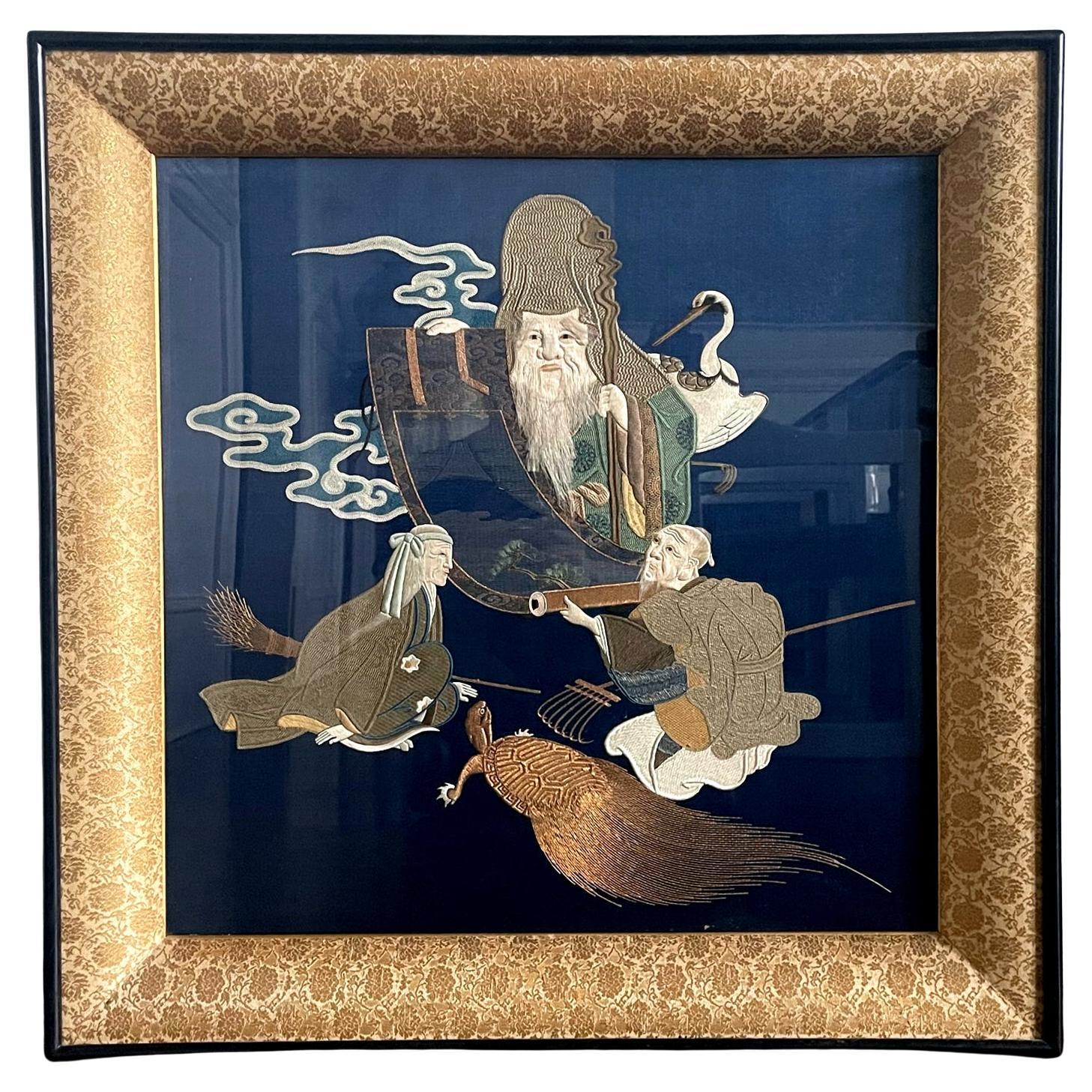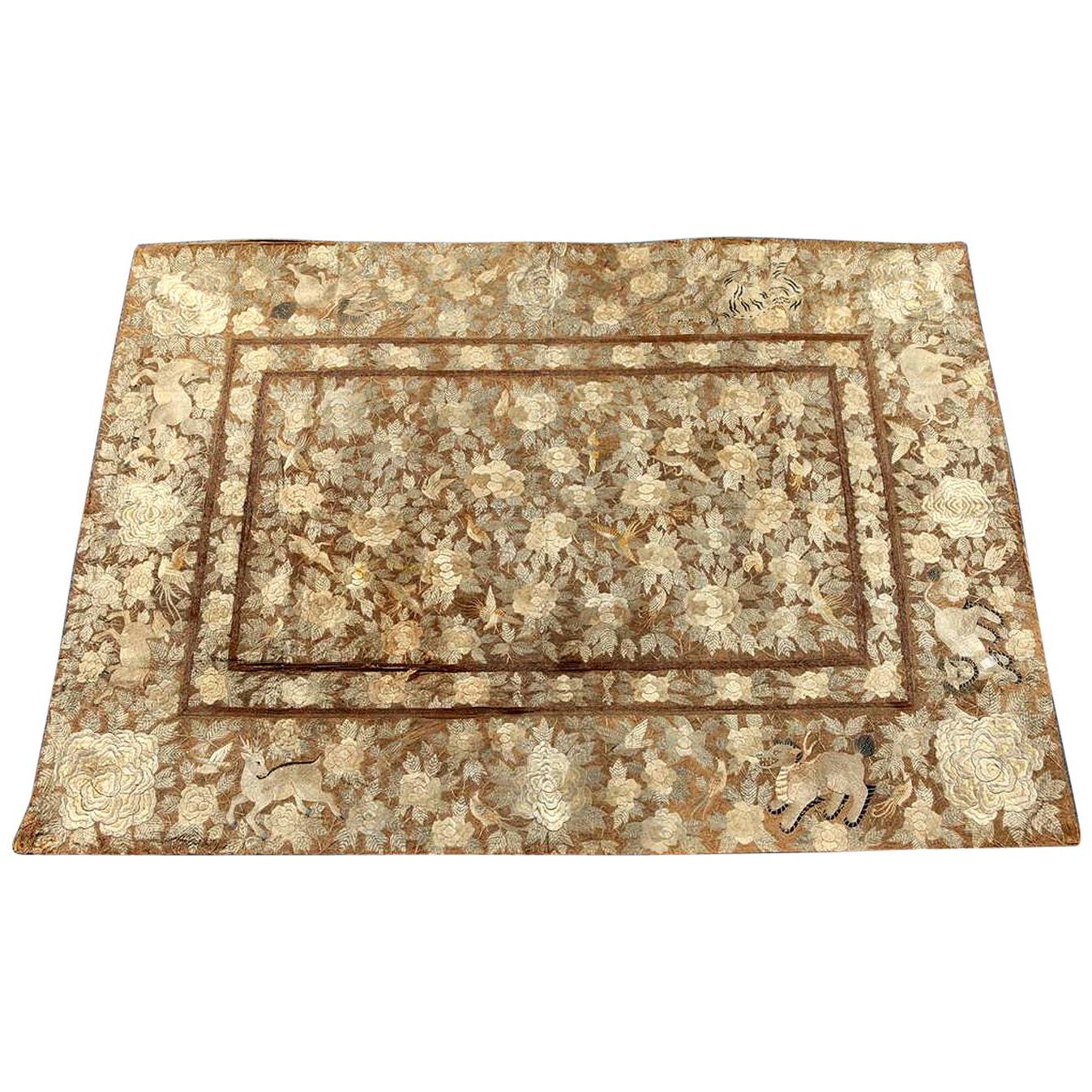Items Similar to Antique Japanese Export Silk Embroidery Americana Patriotic Panel
Want more images or videos?
Request additional images or videos from the seller
1 of 14
Antique Japanese Export Silk Embroidery Americana Patriotic Panel
About the Item
A silk embroidery panel that depicts an American eagle perched on the liberty shield, with laurel branches and shooting arrows under the feet and flanked by four American flags and banners on the back. Thirty six large stars are scattered on the flags and the motto "E. Pluribus Unum" is embroidered on a fluttering ribbon.
In 1854, after Matthew C. Perry, the commodore of the United States Navy Perry, succeed in the opening of Japan to the West following the Convention of Kanagawa, Japan ended its isolation and closure to the west for the previous centuries. Seaports such as Nagasaki and Yokohama opened to the trades and foreign visitors such as sailors, businessmen and missionaries. These type of embroideries were produced as "cruise souvenir" to meet the demand of these new clients, typically the sailors from Britain and America. Outwardly American in subject manner, the techniques and methods were traditional Japanese and the work displays superb craftsmanship. Interestingly, these silk panels provide a historical snapshot of the contemporary events in America at the time. The presence of the thirty six stars dated the piece between 1865-1867, shortly after the Civil War. "E. Pluribus Unum" (Out of many, one) was the de facto motto of the United States from its early history until 1956.
The silk panel is not only a piece of Japanese textile art, it is also a great regalia of America history.
For literature and reference see Threads of Silk and Gold Ornamental Textile from Meiji Japan (Ashmolean): pager 74.
- Dimensions:Height: 26.5 in (67.31 cm)Width: 20.5 in (52.07 cm)Depth: 1 in (2.54 cm)
- Style:Japonisme (Of the Period)
- Materials and Techniques:
- Place of Origin:
- Period:
- Date of Manufacture:1865-1867
- Condition:Wear consistent with age and use. Fine antique textile condition with minor wear, frame shows some expected aged wear.
- Seller Location:Atlanta, GA
- Reference Number:1stDibs: LU945025251612
About the Seller
5.0
Platinum Seller
These expertly vetted sellers are 1stDibs' most experienced sellers and are rated highest by our customers.
Established in 2006
1stDibs seller since 2010
479 sales on 1stDibs
Typical response time: <1 hour
- ShippingRetrieving quote...Ships From: Atlanta, GA
- Return PolicyA return for this item may be initiated within 2 days of delivery.
More From This SellerView All
- Antique Japanese Export Silk Embroidery Panel of American UnionLocated in Atlanta, GAA rather fascinating silk embroidery panel that depicts an American eagle perched on a shield, with laurel branches and shooting arrows under the...Category
Antique Late 19th Century Japanese Japonisme Textiles
MaterialsSilk, Wood
- Framed Antique Japanese Silk Embroidery Fukusa Textile PanelLocated in Atlanta, GAA Japanese Fukusa Panel with tassels displayed in a gilt frame circa Meiji Period. Fukusa is a traditional Japanese textile art used as a...Category
Antique Late 19th Century Japanese Meiji Textiles
MaterialsSilk, Wood
- Framed Japanese Embroidery Textile Panel RootstersLocated in Atlanta, GAA matted and framed Japanese silk panel with elaborate embroidery circa late Meiji to Taisho period (1910-30s). On a bright background, two rooster...Category
Early 20th Century Japanese Japonisme Textiles
MaterialsSilk, Wood
- Framed Antique Japanese Embroidery Fukusa PanelLocated in Atlanta, GAA finely embroidered Japanese silk Fukusa panel presented in a beautiful silk-lined giltwood frame (newly framed and glazed), circa late 19th century of Meiji Period. Fukusa is a tra...Category
Antique Late 19th Century Japanese Meiji Textiles
MaterialsSilk, Wood
- Framed Antique Japanese Embroidery Fukusa PanelLocated in Atlanta, GAA finely embroidered Japanese silk Fukusa panel presented in a beautiful brocade-wrapped fame. Circa late 19th century of Meiji Period, Fukusa is a traditional Japanese textile...Category
Antique Late 19th Century Japanese Meiji Textiles
MaterialsSilk, Wood
- Antique Japanese Embroidery TapestryLocated in Atlanta, GAA large Japanese silk embroidery tapestry circa 19th century, late Edo to early Meiji period. Meticulously handwork that densely depicts repea...Category
Antique 19th Century Japanese Japonisme Textiles
MaterialsSilk
You May Also Like
- Japanese Indigo Antique Boro Futon Cover or Wall PanelLocated in Alessandria, PiemonteRare perfect antique collection Japanese Indigo Boro Futon cover : also to use. The rare antique boros are now valued as pieces of art, therefore they are...Category
Mid-20th Century Japanese Japonisme Textiles
MaterialsCotton
- Chinese Silk EmbroideryLocated in Wilson, NCThis silk lion embroidery is in a molded faux painted frame. It depicts a male and female lion walking in a tall grassland and is stitched in very intricat...Category
Antique Early 1900s Chinese Tapestries
MaterialsSilk, Glass, Wood
- Japanese Indigo Dyed Old Embroidery Cloth / Japanese Toy Pattern / 1912-1960Located in Sammu-shi, ChibaIt is a Japanese indigo dyed antique cloth. It calls its name "fu-ro-shi-ki". Originally used in the dressing room of the public bath "furo" during the...Category
Early 20th Century Japanese Showa Textiles
MaterialsCotton
- Antique Chinese Chinoiserie Silk Embroidered Floral Panel Table RunnerLocated in Dayton, OHLarge antique framed Chinese black silk folk art textile / tapestry panel or table runner embroidered with brown, gold and blue flowers / leaves. ...Category
Early 20th Century Chinoiserie Textiles
MaterialsSilk
- 1920s Silk Chinese Embroidery ( 3' x 3' 6" - 92 x 107 cm )Located in New York, NY1920s Silk Chinese Embroidery ( 3' x 3' 6" - 92 x 107 cm )Category
Antique Early 1900s Chinese Textiles
MaterialsSilk
- 1930s Chinese Silk Pictorial Embroidery ( 2' x 3' - 61 x 91 cm )Located in New York, NY1930s Chinese Silk Pictorial Embroidery ( 2' x 3' - 61 x 91 cm )Category
Antique Early 1900s Chinese Textiles
MaterialsSilk
Recently Viewed
View AllMore Ways To Browse
Silk And Gold
Silk Embroidery
Antique Art Panels
Embroidery Textile
Embroidery Embroidered
Silk On Silk Embroidery
Antique Textile Art
Japan Textiles
Japanese Textile
Textile Silk Embroidery
United States Navy
Silk Gold Thread
Antique Asian Silk
Embroidery 19th
Americana Furniture
Antique American Flags
Antique American Flag
American Flag Antique





